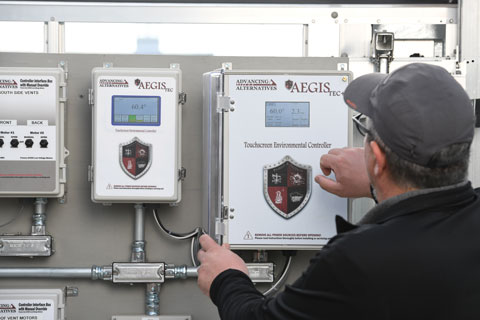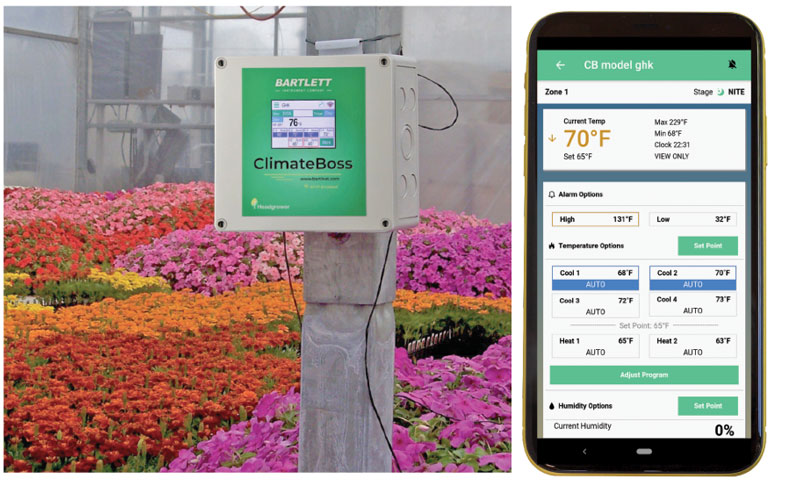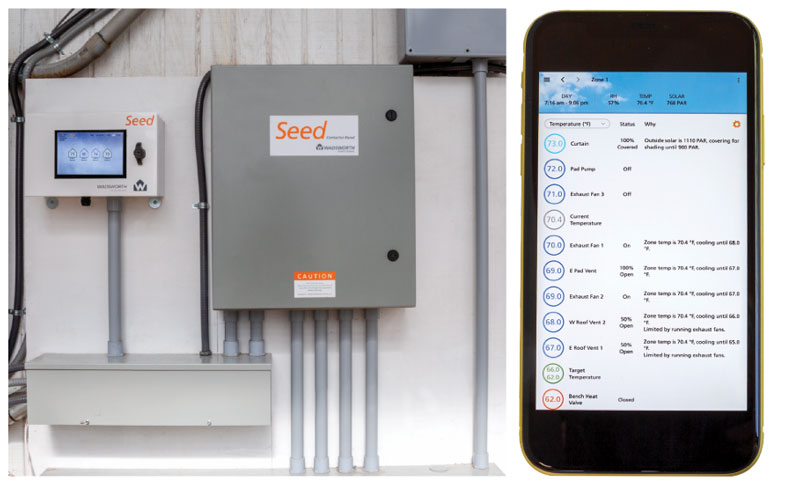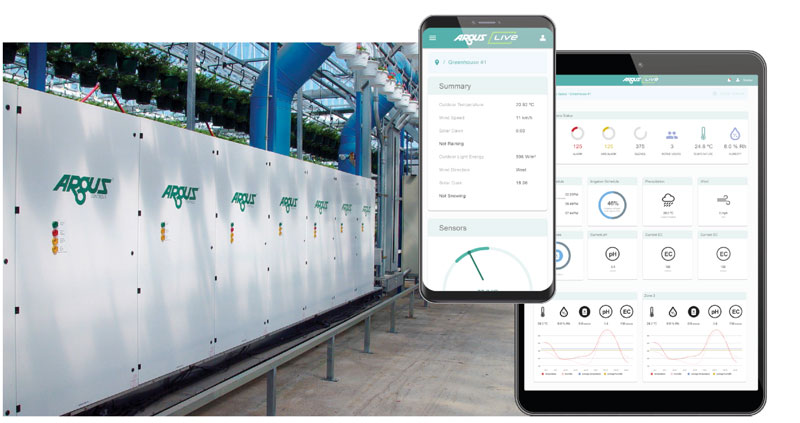6/1/2020
Taking Control
Jennifer Zurko

Some of you may remember a time when you had to stay the night at the greenhouse because of an impending storm to make sure the greenhouse was still standing afterwards. Or the boiler was on the fritz, so you had to camp out on the office couch to make sure the plants didn’t freeze.
Pictured: Advancing Alternatives’ main focus is on providing systems that are “approachable” for small and medium-sized operations.
Some of us also remember what it was like before cell phones, when we actually had to be in the house or near a pay phone to make a call. Or had to use a map for directions. Or had to turn on the news to see the weather forecast (if you missed the window when it came on, forget it).
With new technology comes new ways to make your life easier. You get to access all of your personal and business contacts with a few taps of a touchscreen. GPS apps give you directions in any voice you want (even the voice of Samuel L. Jackson!). And fancy new doorbells have cameras and alerts so you can see who’s at your front door without getting out of your chair.
So it’s not surprising that growers have been asking for similar functionality in their greenhouses, especially when it comes to water management, and controlling temperature and humidity levels. During the last 10 years, companies that develop climate control systems have been taking the framework of other modern tech and using it to their advantage to service their customers.
The technology
“In the old days, the grower was in the greenhouse, the clouds came over or the wind came up and they were there to shut the vents,” recalls Dave Bartlett, president of Bartlett Instruments. “Now everybody is on the move and more mobile, and they want an alert to let them know when the wind comes up or when certain things happen.”
There are two things suppliers say their customers now want with their climate control systems—alerts and remote accessibility. Growers want to know exactly what’s going on and be able to control everything in the greenhouse—from opening and closing roof vents to turning on the heater—anywhere from their smartphone or tablet. So many suppliers have been working on online and cloud-based platforms to allow their customers easier accessibility.
Bartlett Instruments’ introduction of its mobile tool, called Headgrower, has a new WiFi component where every controller can communicate with each other without having to put in wireless capabilities in every single greenhouse.
 Pictured: Bartlett Instruments’ introduction of its mobile tool, called Headgrower, pairs with their ClimateBoss controller and its wireless capabilities to communicate with each other without having to put WiFi in every single greenhouse.
Pictured: Bartlett Instruments’ introduction of its mobile tool, called Headgrower, pairs with their ClimateBoss controller and its wireless capabilities to communicate with each other without having to put WiFi in every single greenhouse.
A few years ago, Wadsworth Controls came out with their Seed controller and they’ve been busy adding a lot of new features. Nick Earls, who handles sales for Wadsworth, said a new mobile app will be unveiled in the coming months that allows a grower “full control.”
“It’s not limited, so whatever you can do on the controller, you can do on the app and it’s the exact same interface, so there’s no re-learning and you can make changes on the fly,” explained Nick.
They’ve also added modulating light control, where a sensor can be placed right at canopy height that measures the amount of light needed at a specific stage of growth, and depending what the sun’s providing, the lights will only turn on enough to get to that level.
“So not only is that providing your crops with a uniform light dispersal, but it’s also saving you on energy consumption,” said Nick.
“Sensors” seem to be a new buzzword with a lot of these control systems.
“Everyone wants it to be very intuitive, everyone wants all the new sensor options to determine whether you’re over-watering or under-watering, and they want a controller that has that,” said Nick.
 Pictured: A new mobile app for Seed will be unveiled in the coming months. This is an example of what the interface would look like by greenhouse zone.
Pictured: A new mobile app for Seed will be unveiled in the coming months. This is an example of what the interface would look like by greenhouse zone.
Far left: Wadsworth Controls came out with the Seed controller a few years ago and they’ve been busy adding a lot of new features.
Argus Controls’ system works very similarly, where it allows you to control a lot of different aspects of the greenhouse with one control module. It’s what Rico Garay calls a very “deep system,” meaning it can do it all, but you don’t have to have it all if you don’t want to.
“There are certain customers that don’t necessarily need all of that functionality and just want to have a very user-friendly, intuitive way to do basic things within the greenhouse,” explained Rico, who’s a key accounts manager for Argus. “So we have our web app platform that allows you to do those types of things.”
The Argus Live app feeds directly into your controls system where you can change set points, set up an irrigation schedule (if you have that as part of your system) and turn equipment off and on. It also allows multiple people to access the system within specific parameters, so that one person isn’t in charge of everything—the person in charge of the vents just has to worry about that control and so forth.
It’s really about the capability that’s been the key to what growers look for in their climate controls and the flexibility to finesse the system whenever they need to. (What can it do for me—now and later?) And mobile and cloud-based technology has allowed control companies to provide these services to their customers.
Accessibility & cost
Owners of smaller operations may have always felt that a high-tech climate control system was a pipedream—the size of their facilities, the fear of not knowing how to use it or the worry about cost may have been previous obstacles. And that may have been true at one point, but now there are many options for growers of every size, technological expertise and budget.
Matt Krum of Advancing Alternatives said that their focus has been on providing systems that are “approachable” for small and medium-sized operations—more user-friendly and reasonably priced. Their customers have been asking for a system that’s easy to acquire and maintain. It’s still an advanced system that you can operate via your smartphone, but it’s also affordable at under $3,000.
“In this market, it had been common for a controller to have unique nomenclature that made for difficult translation,” said Matt. “We wanted our interface to read in plain English to provide a high-comfort level of setup. We knew that the market could benefit from something that was simple, easy to understand and to operate.”
Ideally, you’d have one system that controls everything to avoid redundancy and additional work—not just for the environment, but irrigation, curtain systems and nutrition regimes, too—and that’s not always the case. In our industry, climate control suppliers many times find themselves playing in the same sandbox with competitors, other automation companies and greenhouse manufacturers to service one customer. But it’s all good when you work with others that have the same goals in mind.
“A lot of it is just working through your relationships you have with different greenhouse manufacturers, finding good integrators; people who have a vast offering of things that complement your system,” said Rico. “Ultimately, it ends up being customer driven. From our perspective, our real role is to educate the client on what the best setup for a control system would ideally be. And it’s up to that client and the other parties at the table to understand and decide on what is practical from a wants-and-needs perspective, and what’s practical from a budget perspective.”
What’s “trending”?
As with any product, there are trend patterns depending on what’s popular at the moment. If we looked back at the last 84 years of GrowerTalks and created a graph showing the types of structures that were being constructed by five- or 10-year increments, we’d probably have many peaks and valleys of trendlines.
One recent trend Argus is seeing more of are “closed greenhouses,” meaning instead of controlling the temperature with roof vents, growers are building structures with no openings at all that are controlled with a regular HVAC system. Rico said that this type of system, especially with hydronic (water) HVAC technology, really allows the grower to dial in to the greenhouse environment.
“One of the major advantages of having a closed greenhouse is that you don’t necessarily have as much impact from outdoor factors,” said Rico. “Like in a pad-and-fan system, you’re essentially exchanging air in the greenhouse, so it’s tough to get environmental parameters that are much better than outside because that’s really the basis of the cooling system for these types ofgreenhouses.”
 Pictured: Argus Controls’ system can be as “deep” or as basic as you want—it just depends on what your needs and goals are.
Pictured: Argus Controls’ system can be as “deep” or as basic as you want—it just depends on what your needs and goals are.
An example of the Argus Live app interface for a smartphone and tablet.
Rico explained that when you have a closed greenhouse, you’re not really reliant on air exchange; you have actual cooled or hot air pushing into the greenhouse with a chilled or hot water hydronic fan coil. It’s sort of like taking HVAC concepts you see inside of buildings and applying it to greenhouses. Argus and others are seeing more of these types of closed systems as indoor vegetables, and hydroponic and cannabis production become more popular.
What Matt calls “passive ventilation” is still popular among many growers. And with the automation of greenhouse vents and curtains, a grower can control labor and energy costs, as well as environmental conditions.
Rico said he’s also seeing more of a main exchange, pad-and-fan system with ornamentals growers. But what he feels is most important for these types of growing operations is having good data from your weather station and tying it into your climate control system. Argus offers the option to monitor the weather based on your geographic location and time of year.
Looking ahead
Now that the technology is here and you have a spiffy, modern climate control system, what do you do with it? I mean, it’s really handy for alerts when there’s a problem and to control everything remotely, but it’s also collecting information on what’s going on in your greenhouse—from light levels to temperature. It’s this data that’s going to drive the next stage of climate control systems.
Recently, Wadsworth has been working with Artemis (formerly Agrilyst) to provide tracking software for their Seed system. Within this platform, you can track everything from employee tasks to harvesting product and how much energy and cost goes into each task, said Nick.
Allison Kopf, founder of Artemis, said her company’s role is to provide control systems suppliers ways to collect, measure and report all of the data gathered in their client’s greenhouse.
“As the industry continues to innovate, growers are looking for more than just siloed systems; they require complex reporting, better visualization of data and workflow automation,” said Allison. “Artemis is not a controls system; working with controls companies like Wadsworth helps build a more robust dataset, which ultimately empowers growers with more information. Now, growers can see how climate is affecting plant performance, for example, or have more accurate yield forecasting through Artemis.”
Currently, Artemis is preparing to launch new features to their software platform, including new advanced reporting capabilities, inventory management and post-harvest functionality.
Rico agrees the raw data is important, and how it will be reported and used by the grower will be a primary focus for climate control systems in the future.
“It’s about taking all of this data that we’re constantly collecting and to decipher it to make good, informed decisions,” he said. “And some of the things that [Argus has] been working on in the background is finding ways to make our user interfaces and our systems easier to use and navigate so that customers can get to the information that’s important to them.” GT